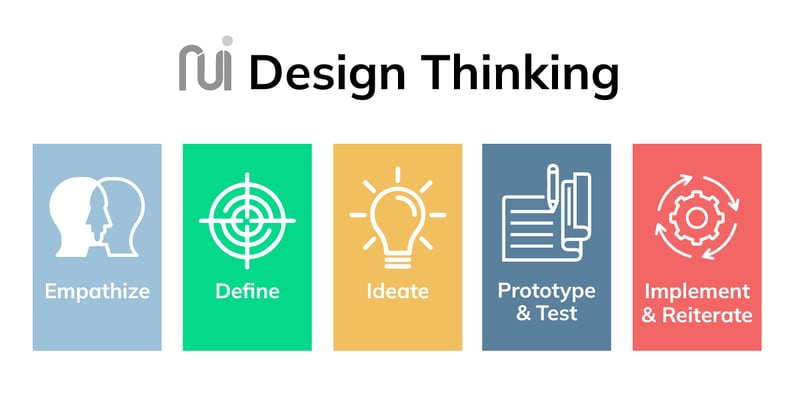How to Improve CX through Human-Centered Design
January 5, 2022 •Rebecca White

Today’s leading organizations focus on delivering excellent customer experience (CX). For successful brands, perfecting CX is a key differentiator in a competitive landscape, since customers expect smooth experiences.
According to a Merkle study, 66% of consumers care more about experience than price when deciding between brands. Brands with a strong commitment to customer experience see higher levels of brand awareness and customer retention and satisfaction.
Generally speaking, customer experience is the relationship between a customer and the business, and it encompasses every touchpoint and interaction. The goal of human-centered customer experience design is excellent services and experiences that make using your business quick, simple, and seamless. Delivering high-quality customer experiences builds brand loyalty and safeguards your bottom line.
Applying design thinking principles is an effective way to improve customer experience. With human-centered design, you can solve business-impacting problems, focusing on what your customers want to identify better ways to serve and support. Here are the 5-steps to creating human-centered CX.

1. Empathize with your customers
The first step of the customer experience design process is understanding your customers and identifying problems you can solve. Step into your customer’s shoes and consider:
- What do end-users say, think, do, and feel?
- What are their needs and motivations?
- How do customers reach your business?
- What, how, and why customers take actions, like using a feature or starting a cancellation?
- Can customers self-serve on your website?
- What is the average wait time for your contact center?
When you’re familiar with your product, it can be difficult to break assumptions and view things from a beginner’s mindset. Empathy exercises like customer journey maps and voice-of-the-customer exercises like qualitative interviews with clients help you connect with customer pain points, challenges, and motivations. Making observations and analyzing data help you identify the root and context of problems.
“It’s about them and for them. The closer the end-users’ needs are analyzed and answered, the more successful the adoption or purchase of a solution. You iterate until you get it right from a customer perspective. This is the power of HCD.”
– Olivier Delarue, UNHCR
2. Define business goals
Take the information you gathered from your customer experience research to craft problem statements. Make sure your goals are specific, measurable, achievable, relevant, and time-bound (SMART goals).
- What are your important KPIs, like average handle time, first call resolution, quality assurance, conversion rate, etc?
- What do you want your customer experience efforts to accomplish?
- What is the timeframe to meet your goal?
3. Ideate ways to transform customer experience
Brainstorm methods to reach your customer experience goals. For example, many businesses struggle with customer retention due to lack of segmentation. Other common pain points are inefficient processes like excessive transfers, or subpar products and services.
Being customer-centered means understanding your customer needs. Some customers may prefer chat, while other customers prefer to connect via phone. Identify and understand your customer needs better with analysis like surveys, interviews, focus groups, and social listening. Then, gather the right teams.
Prevent frustrations, protect against churn, and predict customer behavior to optimize customer experience at every touchpoint with the following points:
- How can you personalize the customer experience for different customer segments?
- How can you maximize first-call-resolution?
- How can you reduce churn based on data analysis?
- How can you improve products or services based on customer feedback?
- What support resources can you provide for customer success? (Example: Knowledge base, FAQs)
4. Prototype and test solutions
Design customer experience solutions that simplify complexity, reduce frustration, and encourage loyalty. Products and services can be prototyped with feedback for continuous improvement. Consider asking the following before prototyping:
- What problem does your solution solve?
- How are your customers currently solving the problem?
- How have previous solutions failed?
- How do the target customers feel about the solution?
- What features are missing?
5. Implement and reiterate
Create an action plan to put your initiatives in motion. Make sure you have the right people, processes, and technology to get the ball rolling. This can include tools like customer relationship management (CRM) software, sales tracking, and quality assurance software.
- What wins did you see after implementing your customer experience transformation?
- What roadblocks or functional silos can you identify?
- How can you improve results in the future?
Gather data and feedback loops to evaluate results. Learn from gaps and challenges to reiterate. Design thinking never stops. Continue to adapt as customer needs and expectations change.
Improve Your Customer Experience
It's our business to enhance your customers' interactions with your brand—growing your revenue, improving brand loyalty, and building a stronger business in the process. A best-in-class BPO like RUI has the expertise to identify impactful improvements and deliver a superior customer experience.
Get in touch to learn how we can outsource your customer service.


